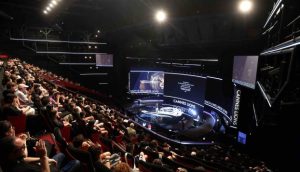As the big winner of strategy‘s Agency of the Year Award at last evening’s gala, Rethink is a deserving successor to Taxi – which grabbed Gold for a record run over the past four years. Vancouver-based Rethink, created by Chris Staples, Ian Grais and Tom Shepansky in 1999 – with a serious funny bone as one of its chief assets – has been fast-tracking towards its first AOY crown after taking Silver last year.
The other agencies recognized during the ceremony at Toronto’s Docks Nightclub were: DDB Canada‘s Toronto shop, which took the Silver award, Toronto-based Lowe Roche, which nabbed Bronze, and Taxi, which took Honourable Mention – while Toronto’s zig and BBDO shops made it onto the list of finalists. Other agencies making the short list for 2006 were Bos, Montreal-based Sid Lee (formerly Diesel), and Toronto-based Leo Burnett Canada, Grip, John St. and Bensimon Byrne.
This year’s AOY ceremony also saw the introduction of strategy‘s B!G Awards, created to recognize the scope of work agencies are doing that goes beyond advertising. The Gold B!G award went to Montreal’s Sid Lee (formerly Diesel), for its idea to reorganize the layout of the Société des alcools de Québec (the province’s liquor board) from regions and country of origin to a more consumer-centric layout focusing on wine pairing, type of flavour and price point.
The Silver B!G went to Leo Burnett for its work for Procter & Gamble on how to build a mega brand. And Cossette Communication-Marketing took Bronze for its plan to help McDonald’s attract youth employees in job-option-rich Alberta.
So which work snagged Gold for Rethink? No question that introducing its hilarious ‘ratvertising’ viral to an unsuspecting world was a biggie. The client was 1-800-GOT-JUNK?, which was in the market for a brand awareness campaign. But because media dollars were limited and the market vast, Rethink opted for outrageousness to reach the target of urban and suburban homeowners 35-65. Enter Ratty. The TV and radio campaign, which centered on the Rat Advertising Trial, showed live rats outfitted in ‘GOT-JUNK’ jackets being released into neighbourhoods. The rats find the junk, the consumers find the rats and GOT-JUNK comes to the rescue.
The campaign’s results were spectacular, adding 60 new franchises to the chain. And creatively, the work was well lauded. It scored impressive PR, was recognized at Cannes and in the Communication Arts Annual, as well as being featured on US network TBS’s World’s Funniest Commercials. Well played, Ratty.
Sporting savvy new mediaverse planning acumen helped DDB Canada take the Silver AOY, particularly for creating unique consumer connections for the Canadian Tourism Commission. To get Americans – who’ve been staying away from Canada in droves in recent years – to return, DDB decided to show the target (18-34s living in Chicago) what a trip above the 49th parallel would be like through the eyes of their peers. So a young couple was sent to Toronto, Ottawa and Montreal to document their experiences.
The images and video were loaded onto 1,000 USB keys along with MP3s of Canadian indie bands, a travel itinerary and video messages from friends. Then the keys were dropped in selected Chicago neighbourhoods. No branding was used, but links embedded in the MP3s took the viewer to www.unknowncanada.com. Murmur boards – intriguing images for subway cards, TSAs, wild postings, bar coasters and urban weeklies – contained only a toll-free number where an entertaining story about the image, as told first-hand by the person who experienced this uniquely Canadian moment, could be heard.
As it turned out, the USB drop far exceeded industry standards for any medium of its kind. While norms for online banner clickthroughs are 15-25% and for direct mail 5%, DDB achieved 25.33% unique viewings with an average viewing time of 4.5 minutes. The CTC plans to roll out the campaign in the U.K., France and Germany for the 2007 tourist season.
Among the work that won Bronze for Lowe Roche was its campaign for the Toronto Zoo, which needed to break through the clutter of summer activities, as well as lure families away from amusement parks. But the zoo’s non-profit budget meant they needed to effectively trigger buzz in the Greater Toronto Area, and unlike in previous years, there was no new visiting attraction.
The consumer insight elicited by Lowe Roche’s research was that people think ordinary animals are not as exciting as zoo animals. The campaign therefore centered on the jealousy everyday animals like squirrels, cats and pigeons purportedly feel toward their more exotic counterparts. The resulting work was multiplatform and included a 30-second TV spot, print, cinema and a microsite showing jealous animals in action.
Unquestionably the funniest aspect of the campaign was the staging by the agency of a ‘pigeon protest,’ complete with media kits from disgruntled pigeons, a pigeon manifesto, video of the protest and comments from the zoo’s CEO. A blog was created with footage from the protest and the spot. Hotmail and YouTube were also used to interact with the younger target. It all worked. The buzz created around the city was impressive and included a full-page cover story in the National Post. Online, there were 100,000 hits to jealousanimals.com. And best of all, attendance at the zoo shot up over 7% versus summer 2005, which made for a record year.
Check out the complete list of winners in strategy, which explains the judging process and delves further into the work that made it happen: www.strategymag.com/aoy.






















